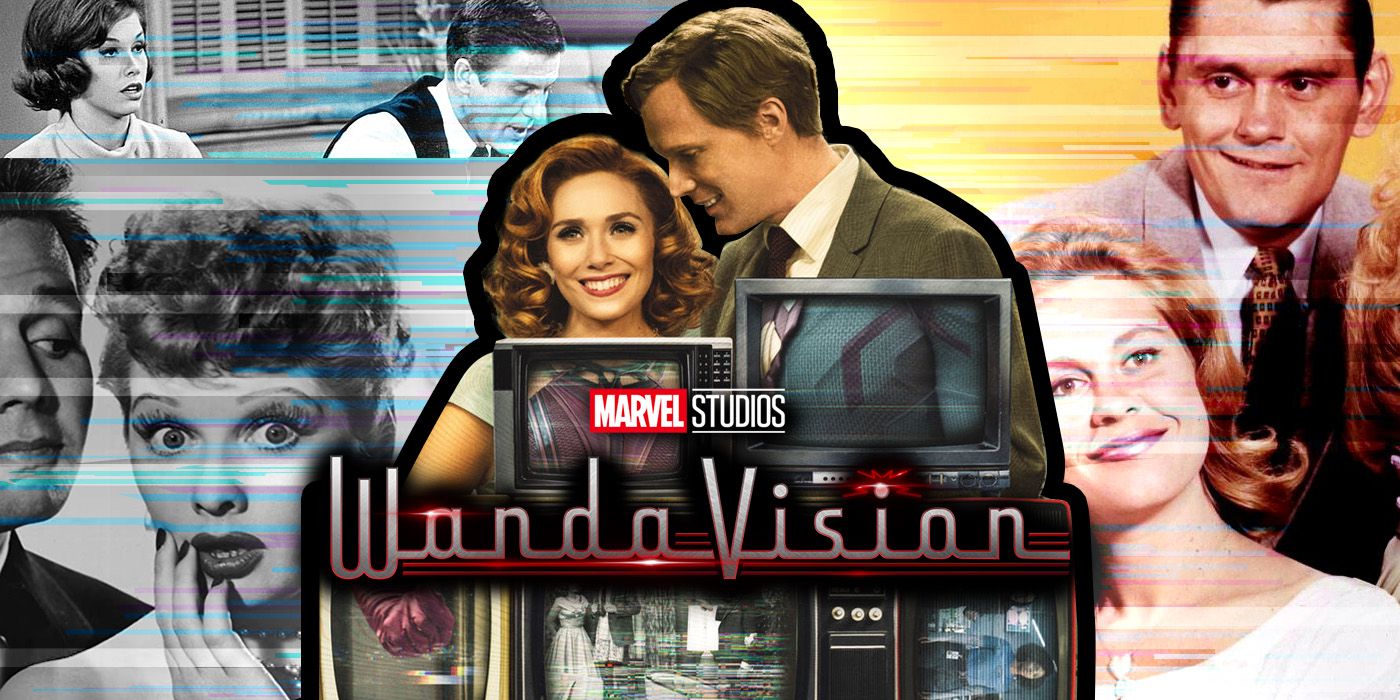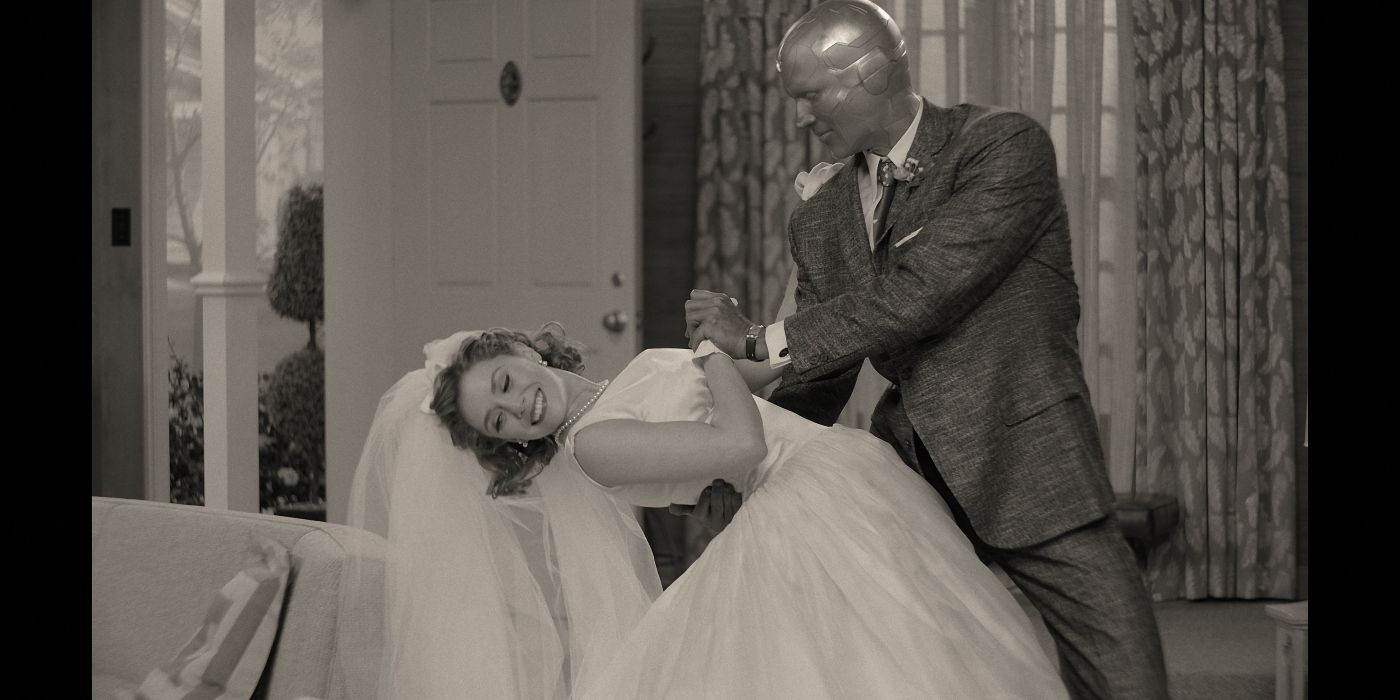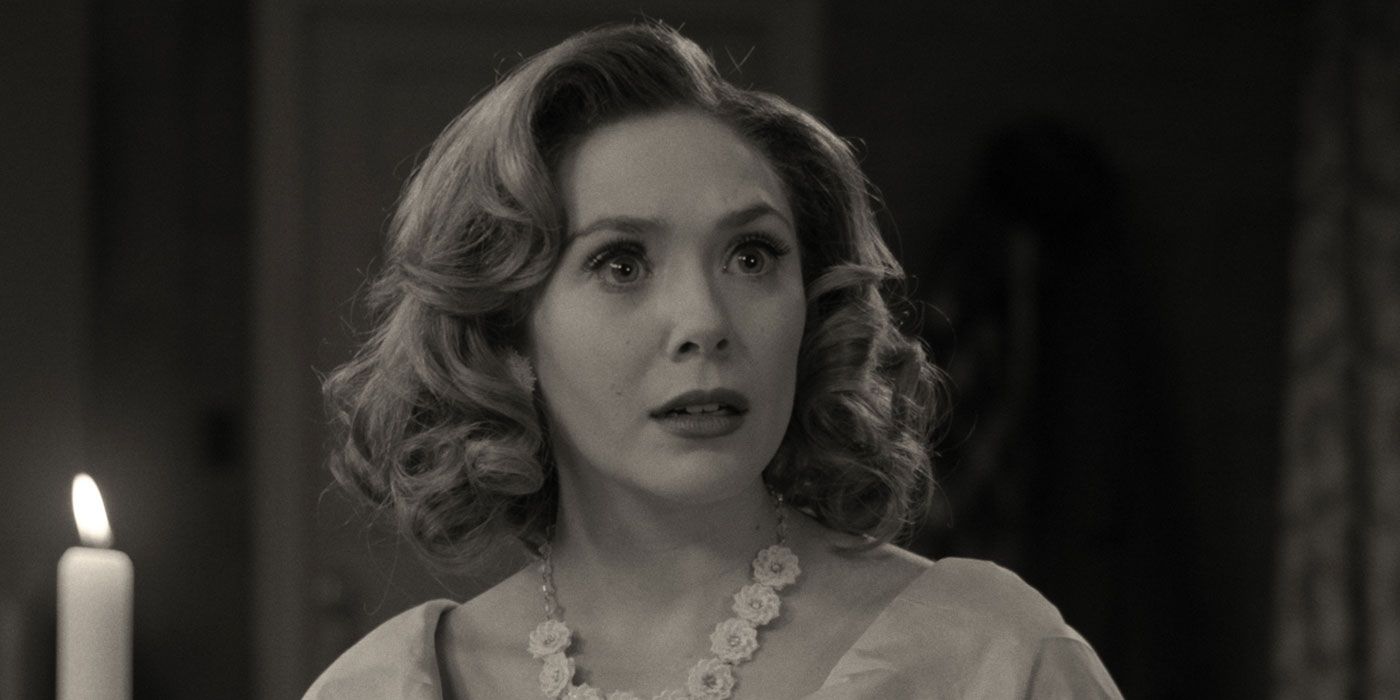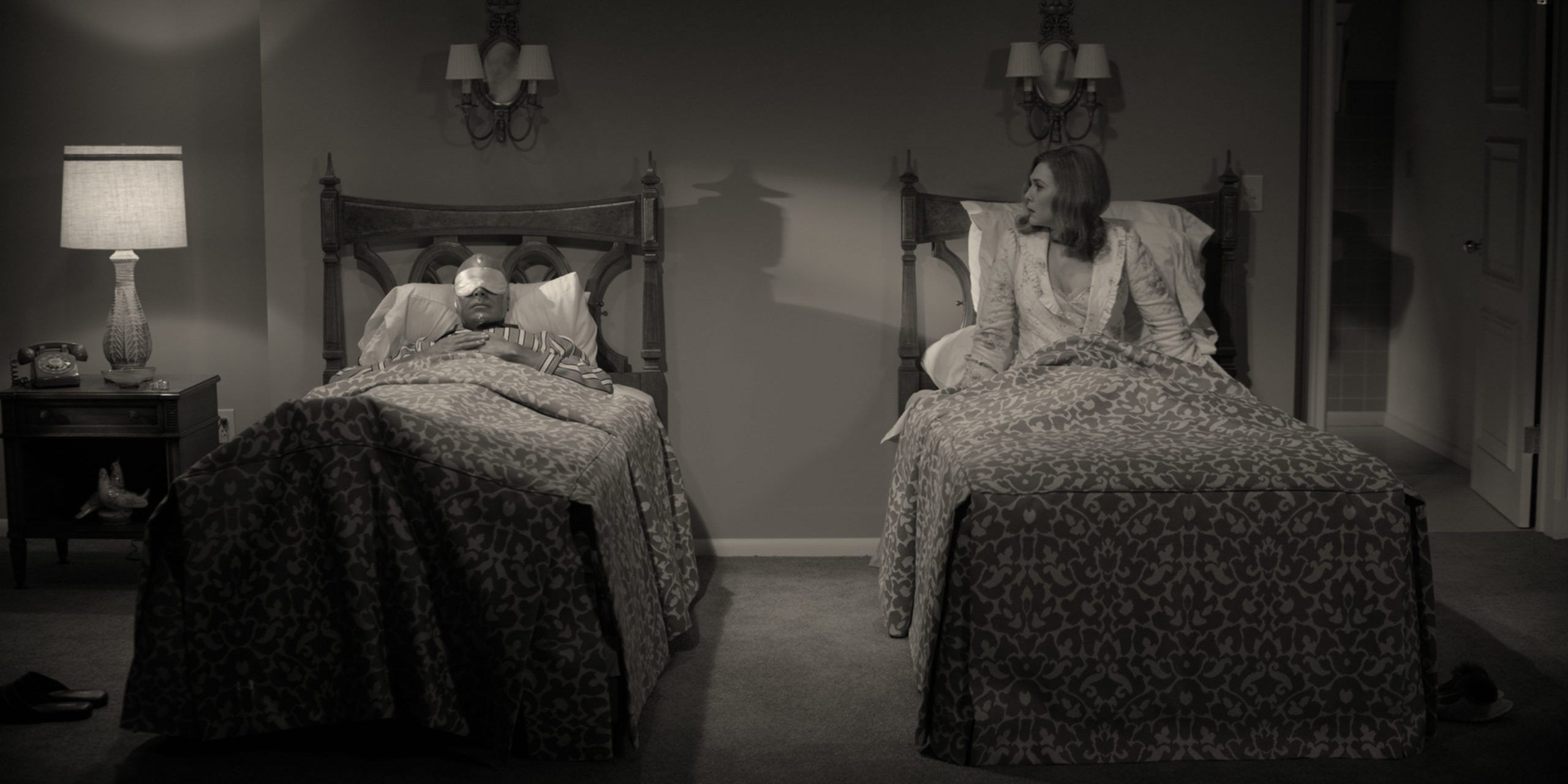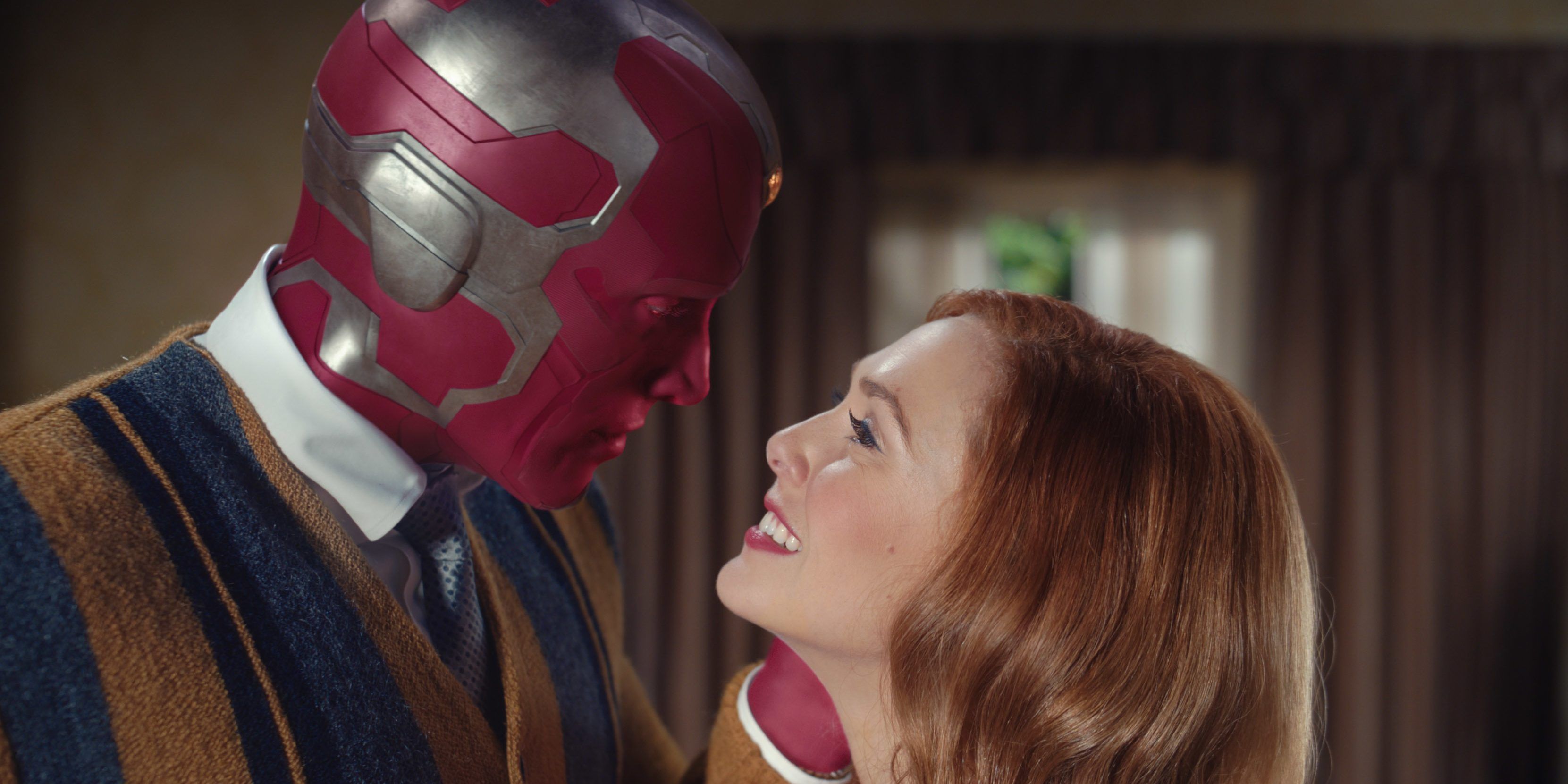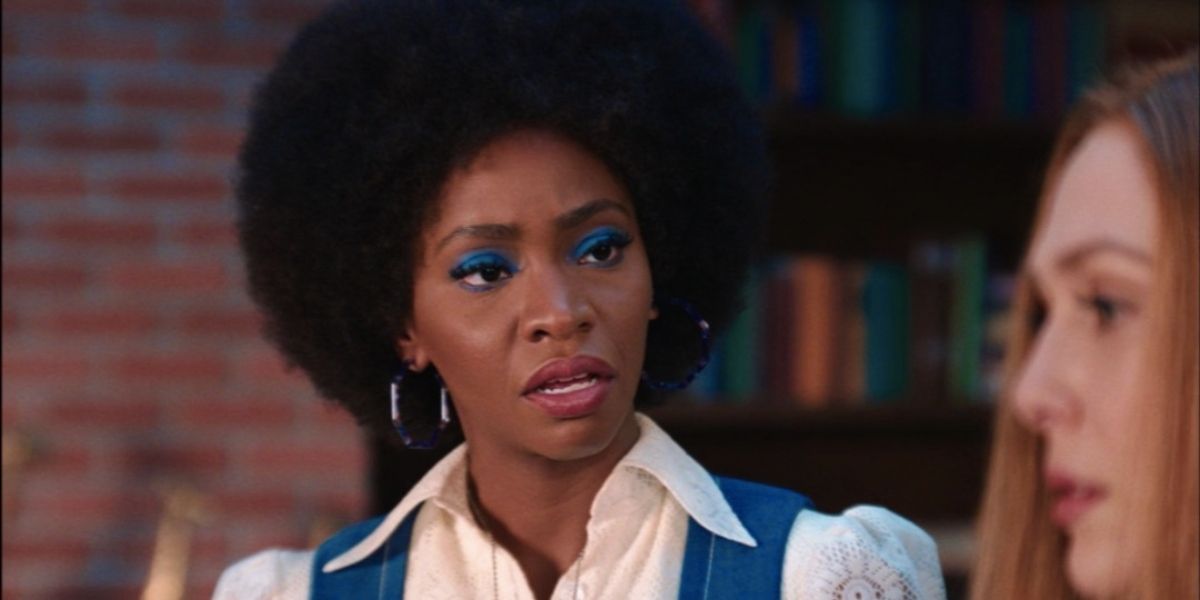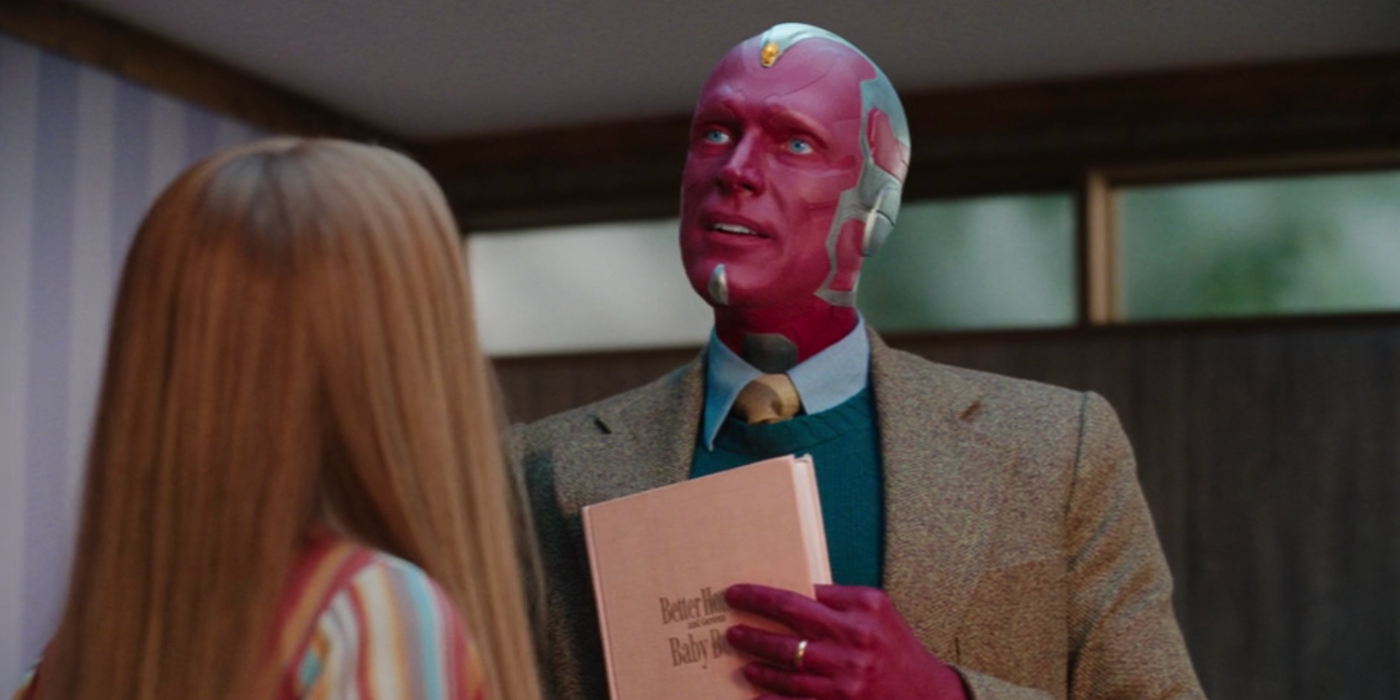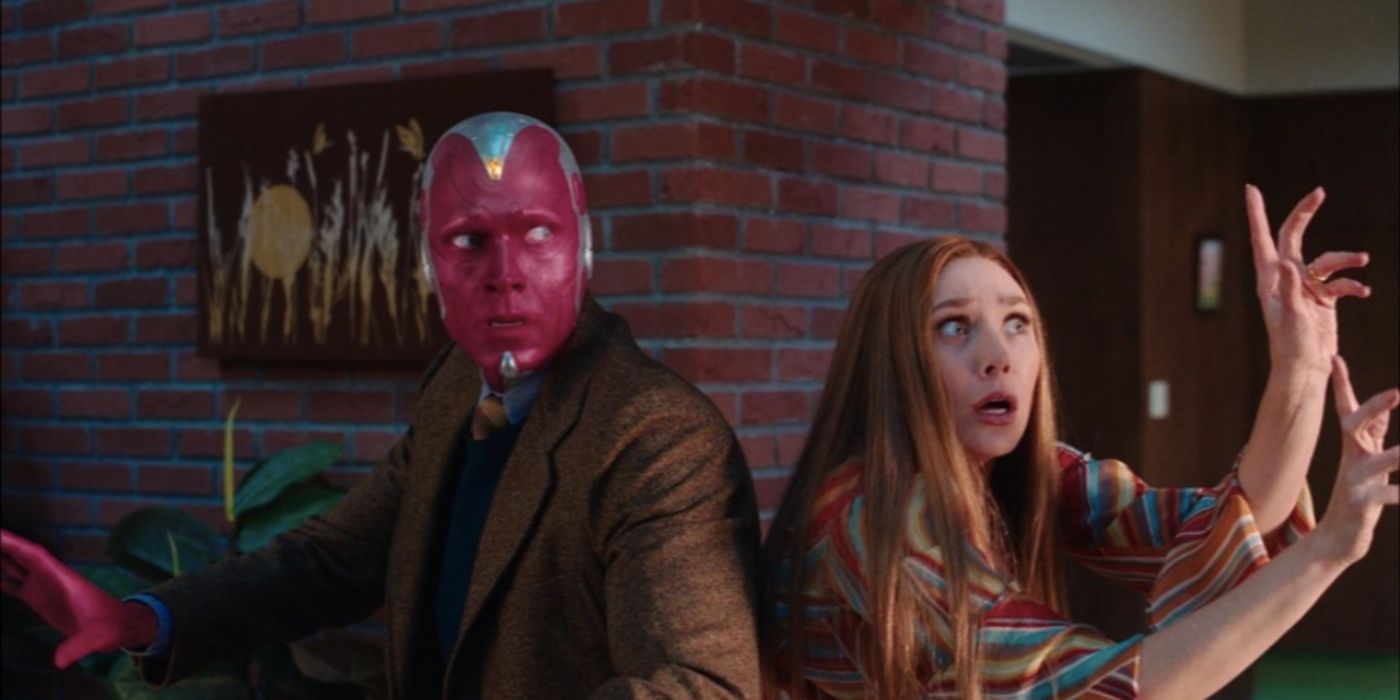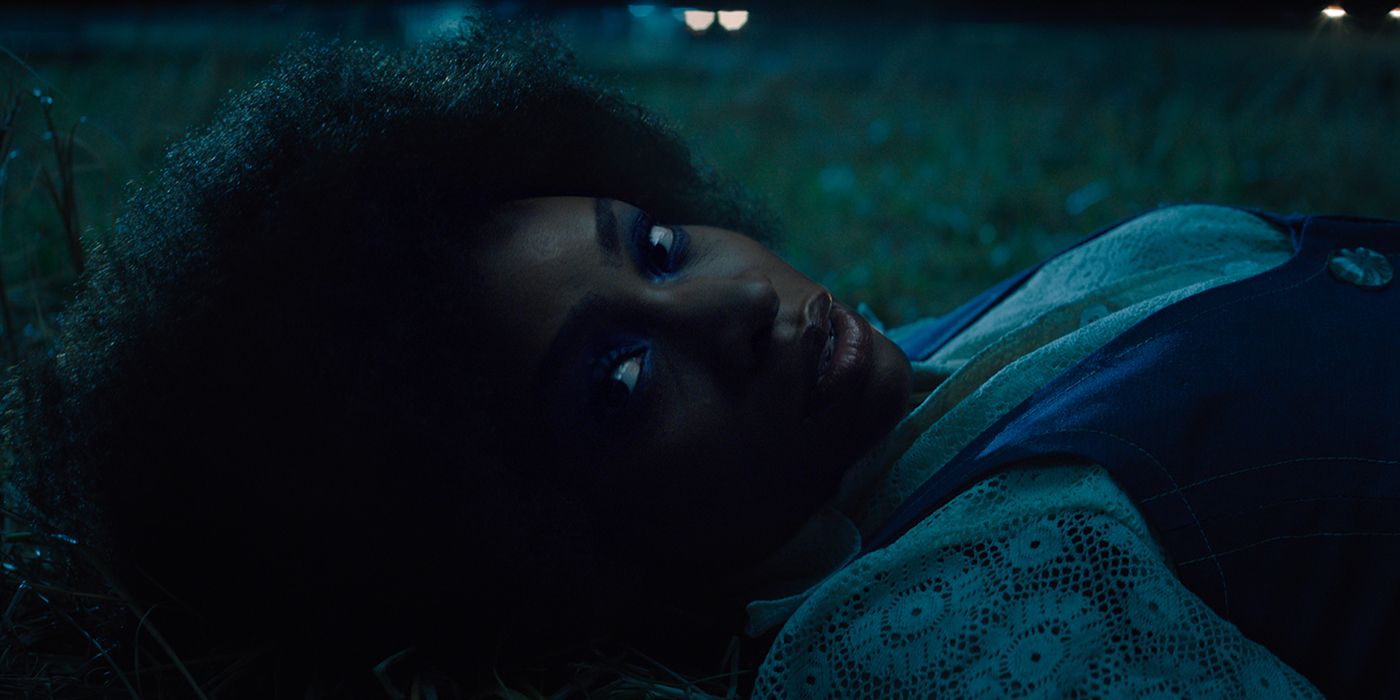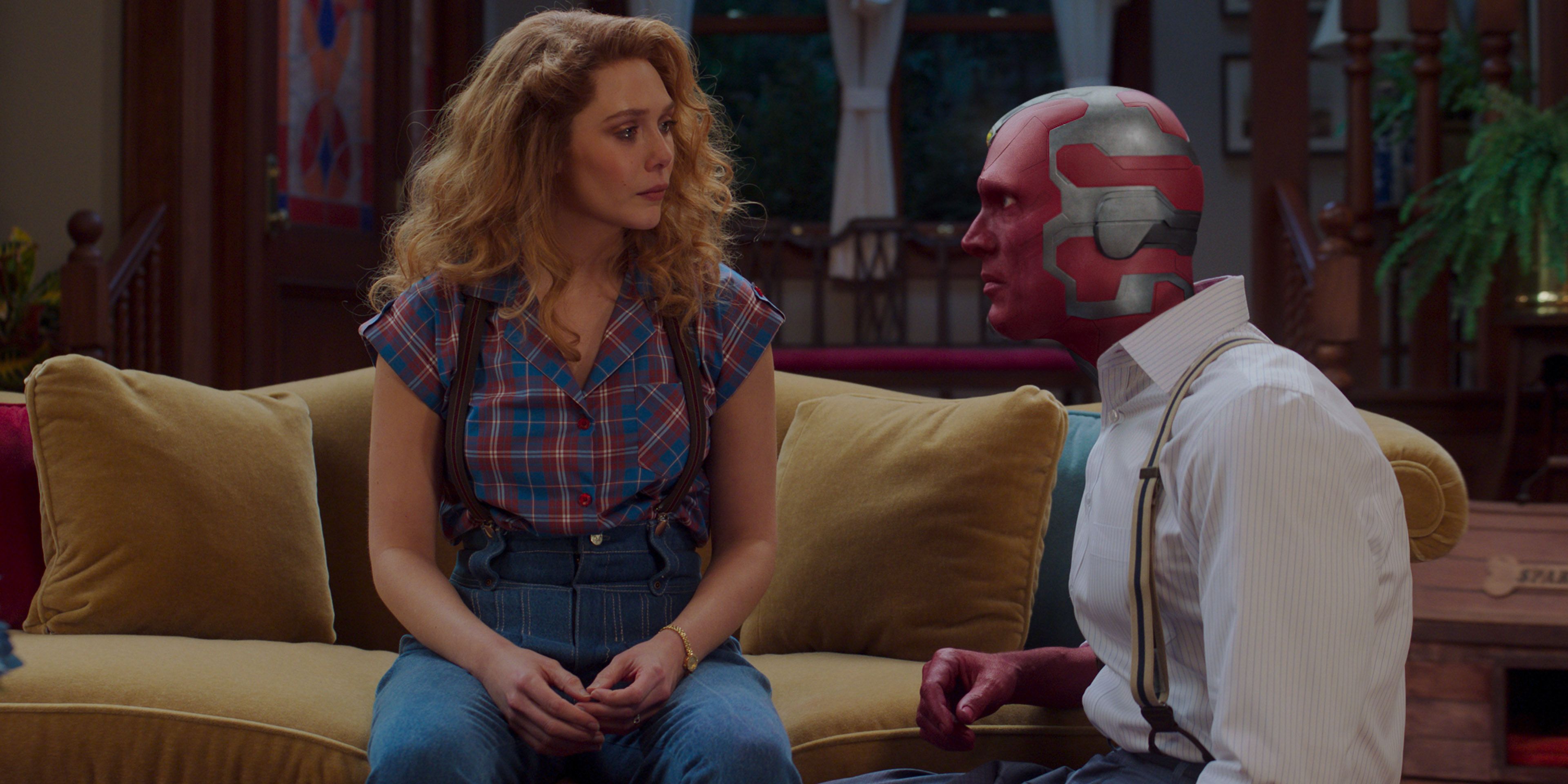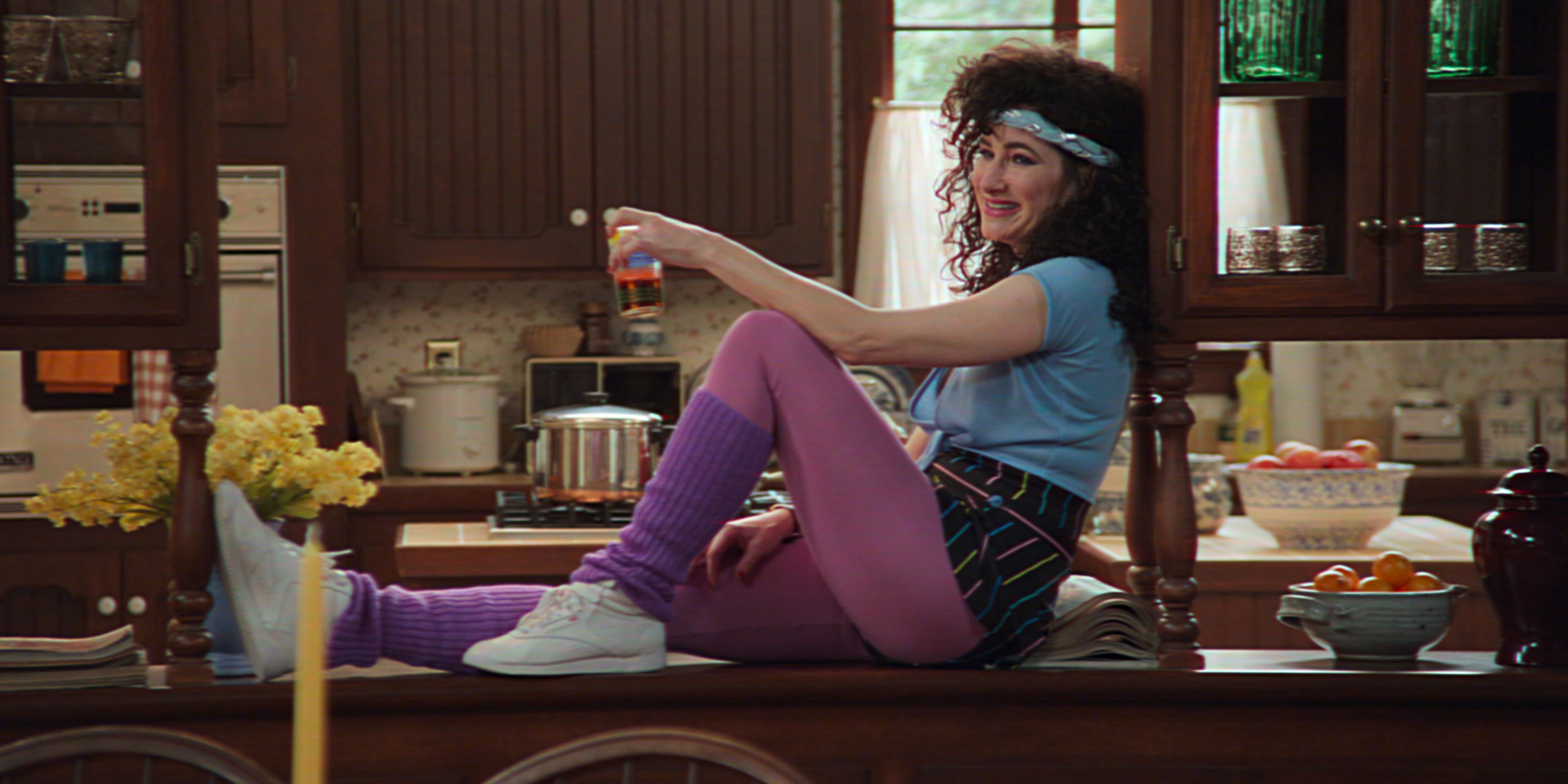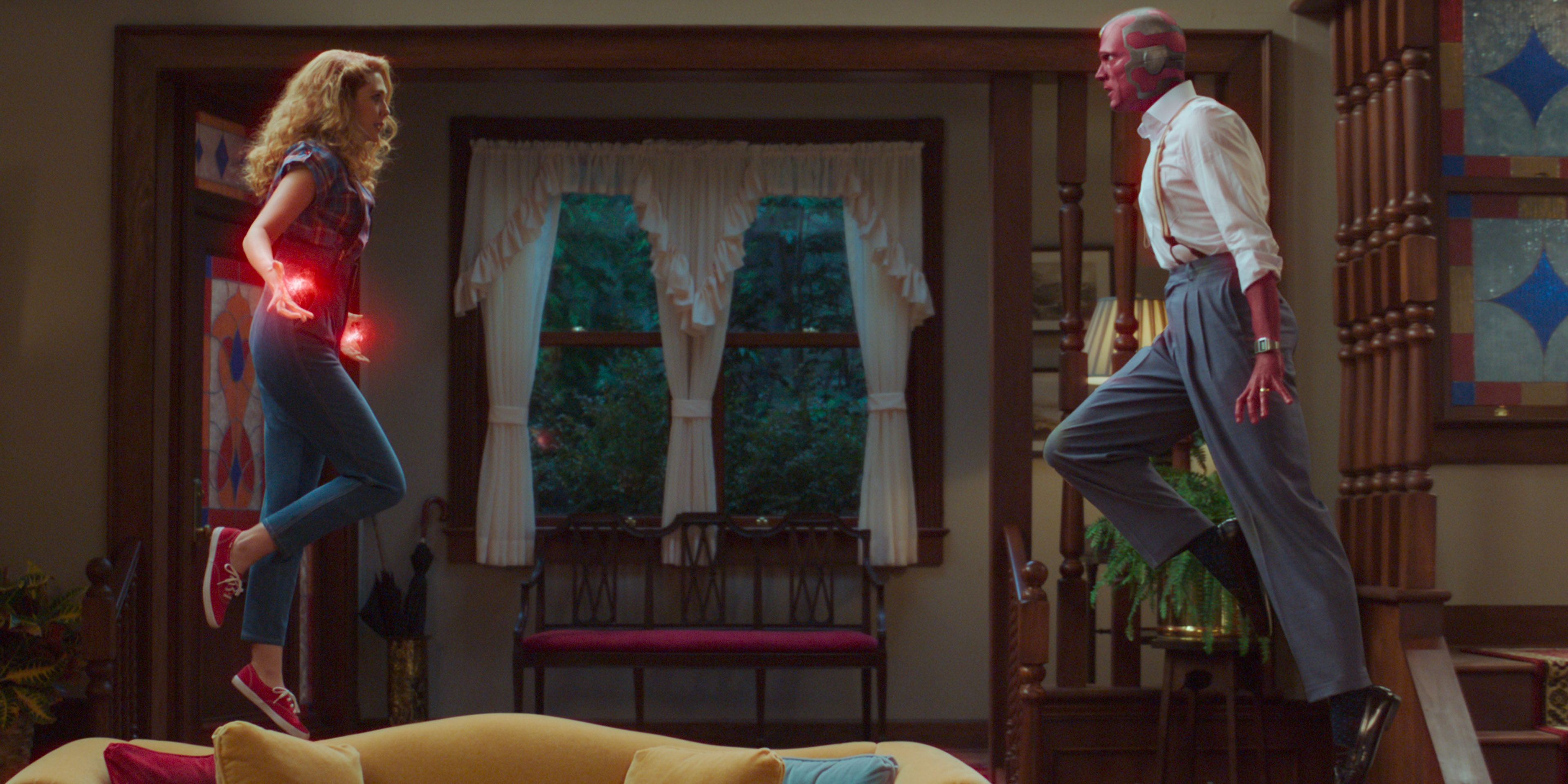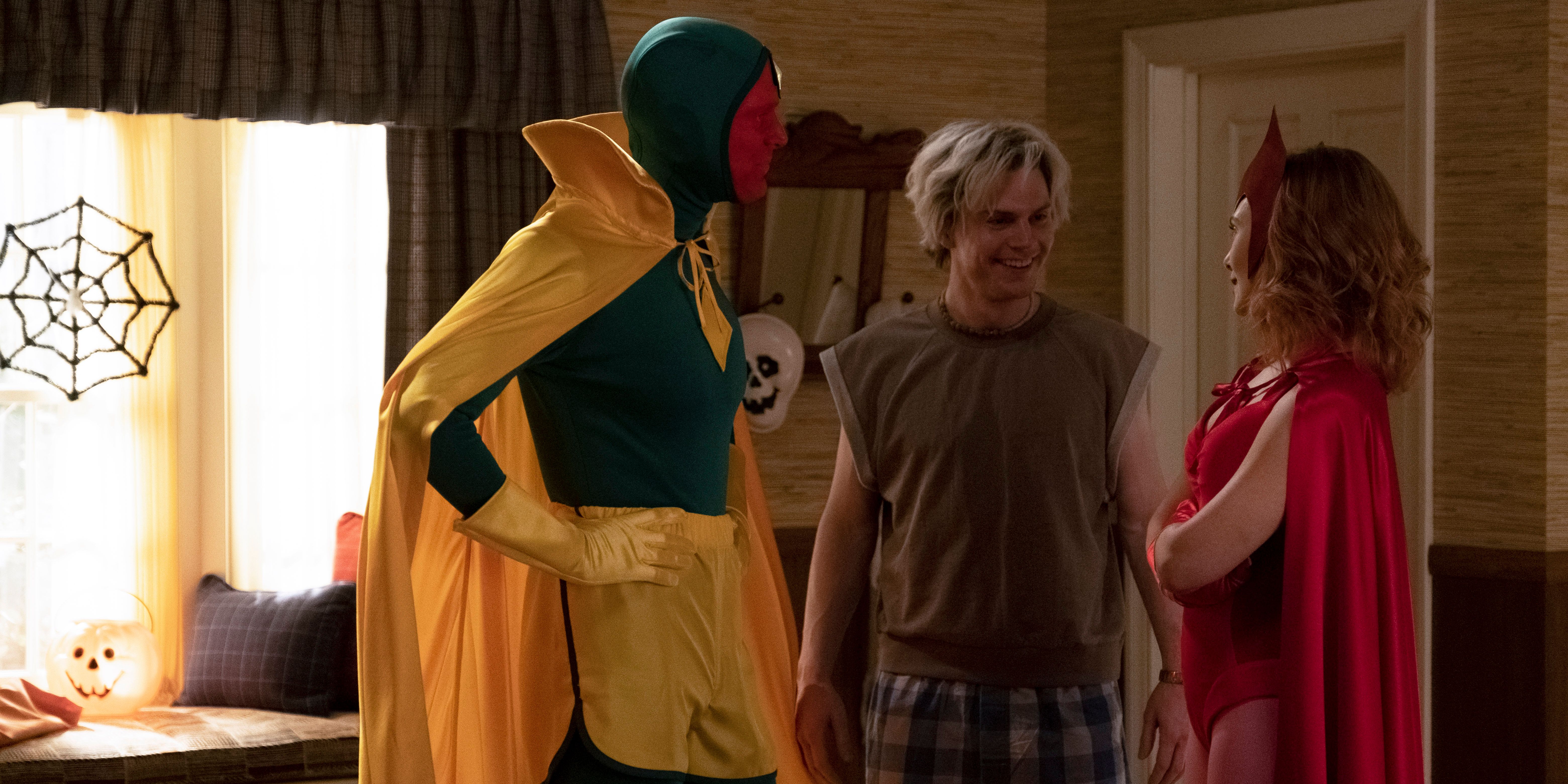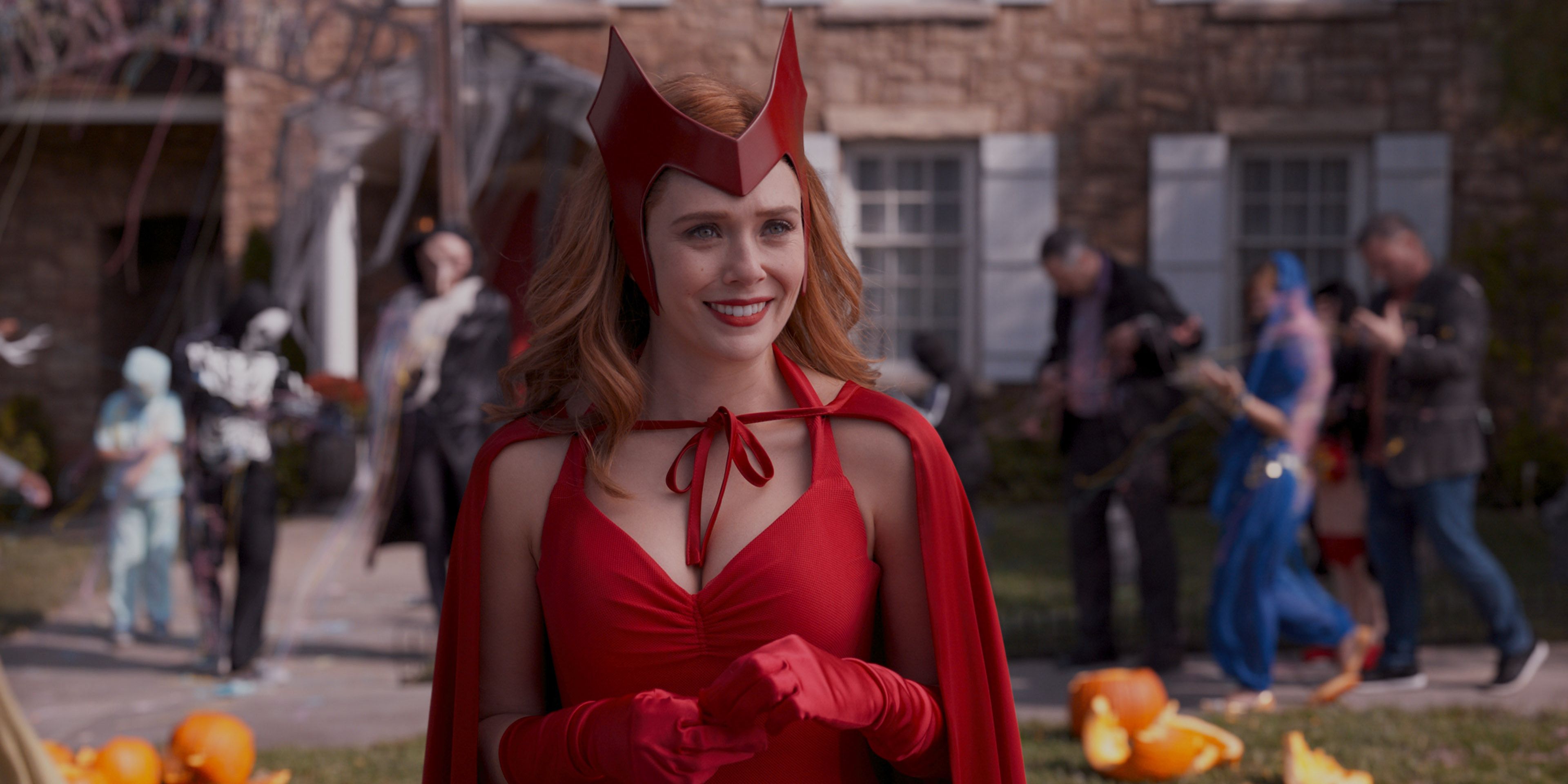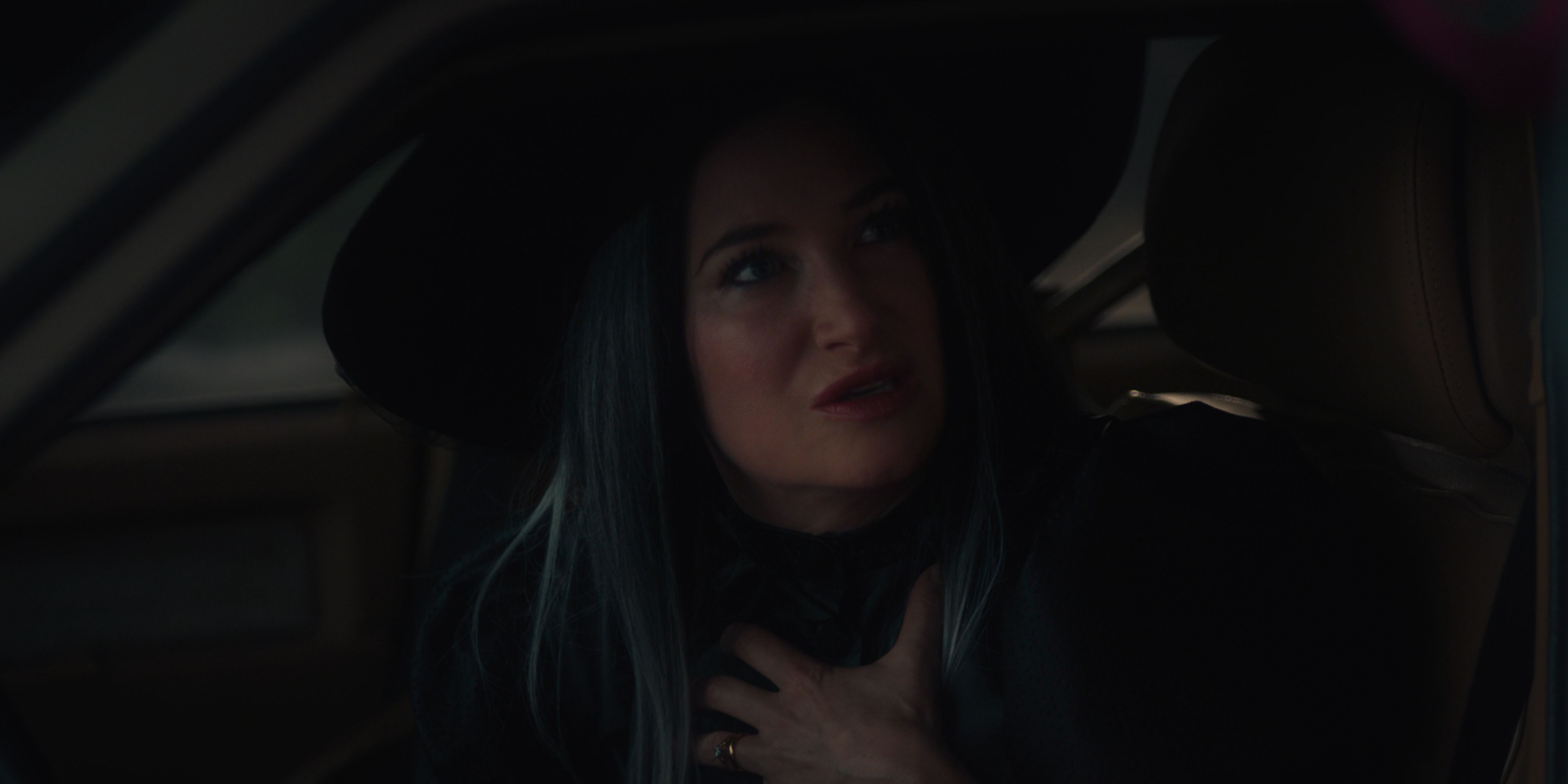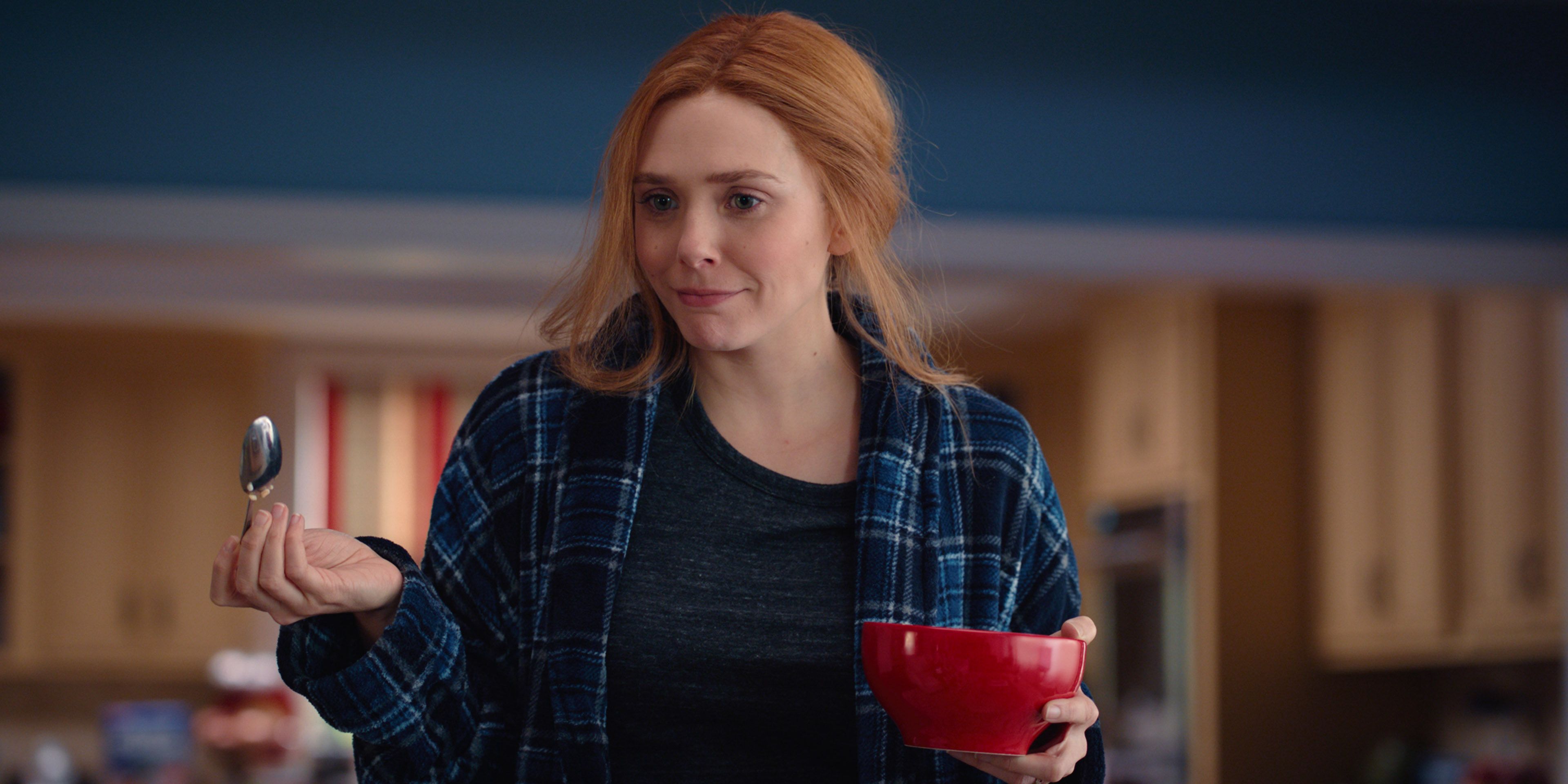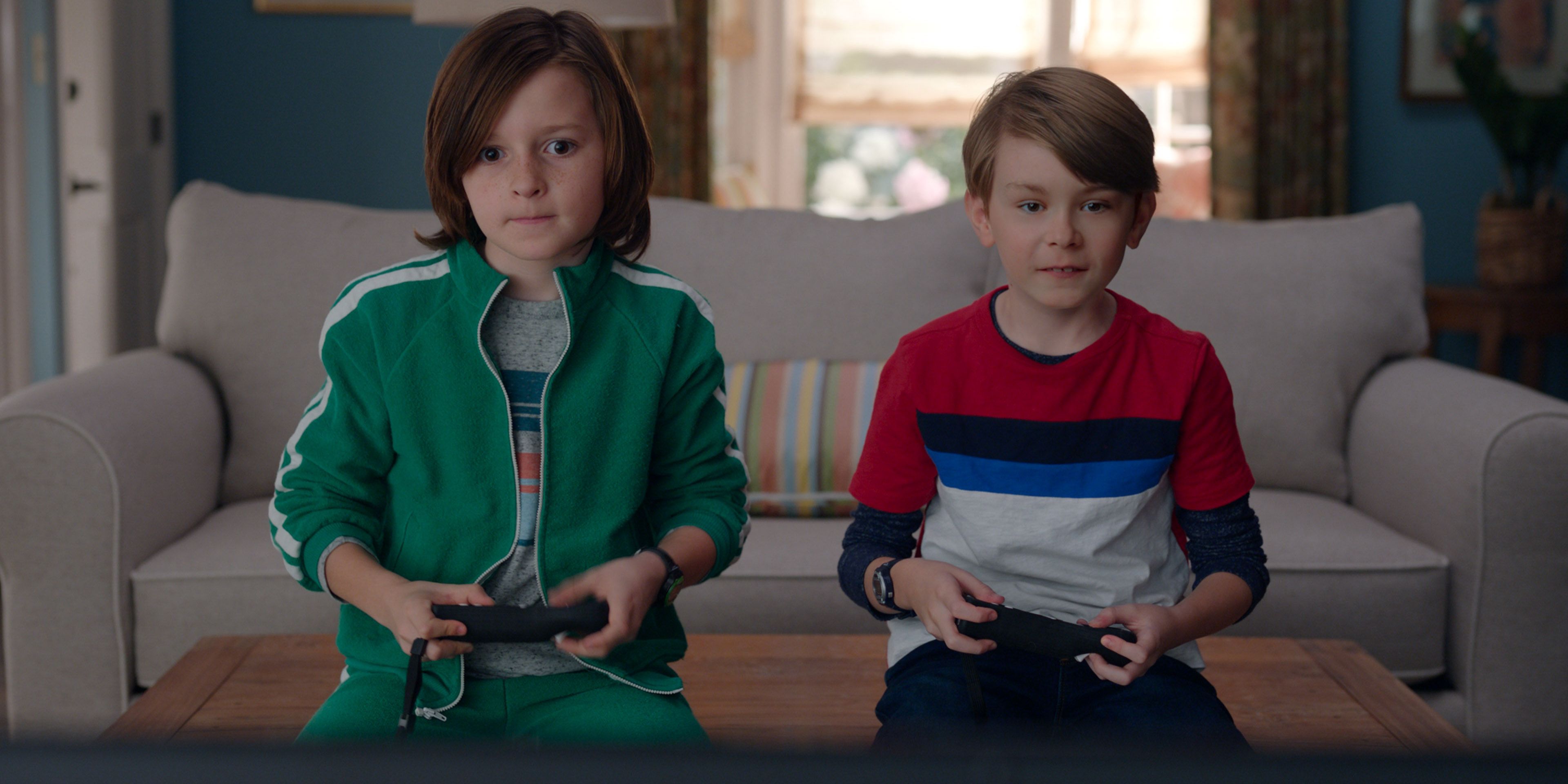[Editor's note: The following contains spoilers through WandaVision, Season 1, Episode 7, "Breaking the Fourth Wall"]
WandaVision is weird, but not without precedent. The MCU/Disney+ television show takes its cue from the genre and formal conventions of broadcast television, and even (especially?) in its earliest, most formative years, broadcast television has been weird — partially because of its status of intimacy within the American household, partially because the early talent pool consisted of vaudeville and theatre writers/performers who were more than willing to muck with people out of the gate, and partially because the creators of the form needed to immediately set themselves apart from the golden removedness of seeing a film at the cinema. George Burns interrupted the plotlines of The George Burns and Gracie Allen Show to speak directly to the audience about what they were watching; Ernie Kovacs disrupted the early visual language of television to present a series of surreal, form-breaking vignettes; and now, WandaVision is here to heighten and jam all of this into a pleasing, gripping, and very, very, very weird blender.
In an effort to track exactly how WandaVision dialogues with television tropes, forms, and sitcom styles before it, we will be unpacking every episode's references and engagements, giving you a clue into just how creatively unprecedented this MCU series is, but also a brief history of broadcast television itself. Shall we begin?
Episode 1 - "Filmed Before a Live Studio Audience"
Episode 1 throws us squarely into classic 1950s sitcom territory, giving us the production design, the 4:3 black-and-white photography, and the general visual “vibe” of these types of shows immediately. I Love Lucy, Leave It to Beaver, The Honeymooners (down to Kathryn Hahn’s off-screen husband being named Ralph, Jackie Gleason's leading Honeymooners character) — these are the classic shows WandaVision’s first entry wants us to think about (with the note that the show is more interested in presenting the prosperous middle-class politics of a Beaver than the working-class struggles of a Honeymooners). But the episode also does a touch of future-telling in its obvious aping of Bewitched, a 60s-to-70s sitcom about a witch trying to hide her real identity, not only in its similar premise but in its usage of chintzy special effects (the insert shot of wedding rings appearing, the seam in the jump-cut apparent, is charming and accurate to what you’d see on a Bewitched). Its farcical plotting, its reductive relationship and gender dynamics, its broadly-pitched slapstick multicam performances (in particular, I love Paul Bettany stepping through the piece of furniture in the opening credits, rather than tripping on it like his Dick Van Dyke Show influence might have done); all of these familiar elements are here to soothe and charm you… until they begin to poke at themselves, and poke at you.
The satirical jabs at the post-war baby boomer era are various and effective. Vision goes to work at a job he doesn’t understand, exposing himself to culture he openly finds irrelevant and trite — but that’s okay, because he’s contributing to society’s squeaky-clean images of “success” and “pleasure.” Wanda (Elizabeth Olsen, Emmy-worthy) stays at home, cooking and cleaning, trying to understand why and how she needs to celebrate her husband — but that’s okay, because she’s contributing to society’s positioning of women as housewives, especially thanks to Hahn’s badgering methods of assimilation. The pleasures of this episode are many — the writers, led by creator Jac Schaeffer, obviously understand and love the comedic rhythms, so tightly theatrical in inspiration, of early multicam sitcoms — but they’re all a facade, an attempt at assimilation into this life. And I’m not just speaking of the slowly gurgling idea that Wanda and Vision are escaping their fraught “MCU life” for a more friendly “television life.”
The 1950s economic postwar boom meant that a TV found its way into every suburban household, giving every suburban resident unprecedented access to information — information centered for and controlled by white sources of power that told its viewers to keep fleeing cities to the suburbs, to watch out for the Russians dropping the bomb on us at any moment, to be warned that foreign Communists have infiltrated our America at every corner. It’s okay to isolate yourself from all this pain and inoculate yourself with consumerism, with convenience, with the domestic, easily wrapped up, American exceptionalist pleasures of television comedy.
WandaVision says the quiet part out loud, framing its assimilation story not just as more plot-driven MCU shenanigans, but as an arrow shot at the xenophobic culture of the era that produced such pop culture. In other words, WandaVision is explicitly an “immigrants trying to survive in America” story, and its supporting characters cannot always keep their derision under wraps like they might be able to in an actual TV comedy (or in the “wholesome, polite” society we keep being told the ‘50s were like). When it’s revealed that Wanda emigrated from Sokovia, a fictional Eastern European country, Vision’s boss (the always fearsome Fred Melamed) barks that “we don’t break bread with Bolsheviks.” It’s a stunning piece of social commentary amplified more by its couching within the formal elements of the culture of the time.
This level of textual darkness, of examining the American human’s tendency to other, to fear, to fight, brings us to the scariest moment of the episode, an explicit visual breakdown of our usual friendly multicam method of production and cinematography that happens to introduce a new, if brief, classic televisual influence into the stew. In the nascent world of classical television drama, networks often broadcast “filmed plays,” original pieces of “live theater” broadcast on TV. These works boasted top-tier writing, acting, and directing talent, many of whom cut their teeth in the revolutionary New York theater scene of the time; and from these sterling pieces of work (buy this Criterion Collection set if you want a taste) came a young writer by the name of Rod Serling, who created a show by the name of The Twilight Zone. In both his live plays and his influential horror anthology series, Serling advocated for intense psychological clarity, for an insistence that the scariest monsters were human beings (the Red Scare allegory “The Monsters Are Due on Maple Street” making this point the most explicitly), and for a filmmaking style rife with bold shadows, uncomfortably close lenses, and a general sense of claustrophobia.
The Serling of it all explodes in this one key sequence of WandaVision’s first episode. During their best attempts at hosting a dinner for Melamed and his wife Debra Jo Rupp (herself a “nostalgia-yielding sitcom” vet thanks to That ‘70s Show), a fraught demand for the happy WandaVision couple to share their story and be “regular Americans” turns into a choking hazard for Mr. Heart. As he chokes on his food (breakfast for dinner), the cameras push in slowly, taking us out of our comforting wide shots and flat studio lighting into oppressive singles, shallow depths of field, background lights fading into nothingness as our subjects stay visible in shadowy, sweaty, paranoid, segmented frames. Performance-wise, we see three different reactions to this disruption, this shift into a Twilight Zone. Bettany, eerily, blankly, stares at Melamed, unsure of how to proceed. Rupp, very frighteningly, keeps laughing and telling Melamed in a “joking” matter to “Stop it,” playing this gulf between genre modes like an oppressive security blanket; we have to stay in “sitcom mode” no matter the obvious truth of what’s happening in front of us or we’ll all die. And Olsen finally leans in to this new Zone, dropping her act to say, in an abruptly pointed, lower register, “Vision, help him.” Vision shows his true self by reaching “into” his boss’ throat to remove the food, and suddenly, we’re back to sitcom-land again, everyone pretending we didn’t just have the wool pulled over our eyes, pretending that everything is still fair even as the glasses fall and break.
Episode 2 - "Don't Touch That Dial"
In Episode 2, we jump roughly a decade in genre time into the world of 1960s television comedy. Most specifically, the episode evokes I Dream of Jeannie, a 1965-1970 sitcom also about a powerfully supernatural woman trying her best to seem “normal” in American society, down to its similar animated title sequence and climactic shift into Technicolor (which Jeannie did 30 episodes in). And while we’re not fully shifting into flower-power hippy territory (nor were many of the television comedies on air at the time), elements of sexual innuendo and hip mod culture begin to meld in, as they did on other ‘60s shows like The Monkees, Batman, and The Avengers (not those Avengers). Wanda’s hair is stylish and hip; the musical arrangements are tinged with swanky latin jazz; and an opening scene fuses the separate beds together (a common scene in the early, chaste days of television) into one, ending with a pretty clear promise of sex!
But where some televisual elements of WandaVision begin to progress — including scary but thrilling Pleasantville-esque sequences of specific objects (and blood) starting to pop with color — others stay regressed in an attempt to keep the peace, to ignore societal changes and truths with placations and comforts, to urge its viewers and participants to sink into “this little charade,” as Vision puts it, and not suffer. If we look even a little closer, we’ll start to see how insidious the consumer-comfort-pop-culture complex is: This episode’s fake commercial is for a Strucker watch (as in Hydra member Wolfgang von Strucker), a bold stab at the United States’ tendencies to go into capitalistic beds with ex-Nazi businesses after war, selling their traumatized veterans products from the very people who traumatized them. Vision himself starts to understand this precarious, very American, borderline cultish tightrope walking on the line of fear and acceptance, of buying and secluding, when he attends a neighborhood watch meeting and explicitly accuses a neighbor of being a Communist (a tactic he likely learned not only from his boss, but from watching Senator Joseph McCarthy on television).
Eventually, Vision’s wielding of this lesson takes a darker, more cynical turn — albeit one performed with broad comedy panache by Bettany. It also shows us why WandaVision and the humans who populate it (and, frankly, our actual world) need to use well-known television comedy signifiers to keep everyone safe. Vision and Wanda decide to perform a magic act during the neighborhood talent show. One problem: Vision has assimilated a little too far into humanity, accidentally swallowing a piece of gum, which screws up his inner machinery and, effectively, makes him drunk. Thus, Vision is ready (though unstably so) to show us the actual magic of his and Wanda’s nature, performing tricks for their neighbors that are unexplainably supernatural. The humans are not impressed, not ready to accept Vision and Wanda for who they really are. They are terrified, even angry (later, a more sober Vision remarks that they’ll “string us up for ruining the show”). To placate them, Wanda must (by using her own magic) “prove” that it is “fake” by inventing wires, mirrors, and other apparati to illustrate how they “actually did it”, and most importantly, give these human consumers the sense of superiority and understanding they need to simply keep living.
To be broad about it: We watch and love television because we know it’s fake, controlled, manufactured by professionals who have no desire to place us in danger, make us feel unsafe or unloved, or challenge our self-assigned smartness. Both with its metatextual utilization of classic sitcom tropes and production devices, and here within its explicit Episode 2 text, WandaVision takes this thesis of televisual safety, gives it to both us and its characters somewhat straightly, before bending it all until it breaks. “Tonight we will lie to you, and you will easily fall for it, because humans have a limited understanding,” says Vision to his magic show audience, and he is not wrong. But his television world is a lie, too, one he and Wanda have only a limited understanding of, one we'll watch modify and mutate until it's destroyed, leaving what’s sure to be a heartbreaking wake in its path.
Episode 3 - "Now in Color"
Another episode, another shift forward by one decade in television history! From moment one, you can tell we’re in the 1970s, a time of rapid progression in the television comedy form, as if producers realized they couldn’t put the social unrest and desire for change from the ‘60s back into the genie/Jeannie bottle.
The final moments of Episode 2 leave us in full, living color for this new episode. Wanda and Vision’s house is upscale and slick, with a decidedly warmer color palette throughout; reminiscent both of the suburban working class living room of All in the Family and the upward mobility of The Jeffersons (though admittedly, Episode 3 feels just aesthetically like classic Norman Lear more than its teleplay does). Our new WandaVision theme and score have keyboards and arrangements that instantly remind me of The Doors, a cutting-edge late ‘60s/early ‘70s band that inadvertently helped aestheticize trippy hippy culture.
And perhaps most tellingly of WandaVision’s ultimate point in weaponizing sitcom tropes, our new opening title sequence ends segmenting our characters in tiles, just like the opening titles of The Brady Bunch, a classic ‘70s sitcom that combined our increasingly modernized “family values” (i.e. blended families are okay too!) with a stubborn insistence on 1950s-styled lessons and shenanigans. The Brady Bunch is a template that makes perfect sense for Episode 3 of WandaVision, which takes the idea of “an increasingly modernized family of sorts tries desperately to stay safe in the past” and runs it in fast forward.
This element of “fast forward” most reveals itself in several general TV tropes seen in the episode. Wanda’s abrupt pregnancy results in regular visits from a Dr. Nielsen — as in Nielsen ratings, the dated-upon-arrival methodology for tracking the number of broadcast television viewers (according to Nielsen, the highest-rated TV show of the 1970s by a wide margin was the aforementioned All in the Family, with other notable shows like the similarly-living-roomed Laverne and Shirley and the similarly-nostalgia-yielding Happy Days making big dents). Becoming a “Nielsen family,” a household with a Set Meter (think a box on top of your TV box) that would transmit the information of what the family watched through telephone lines, was a point of pride and responsibility for certain families of this era, even as it undoubtedly served as an invasion of privacy and an act of nosiness from a televisual Big Brother. Wanda and Vision need their Dr. Nielsen to keep up the charade, to appear like a normal apparatus of the television complex even as his very presence undoubtedly reveals the weirdness, the uncontrollable rushedness of their truth.
Speaking of rushed pregnancy, Wanda gets to participate in one of television comedy’s most time-honored traditions: A leading actor hiding her pregnancy! When "Geraldine" (Teyonah Parris, having a blast) comes over to Wanda’s home to gab (and reveal engaging elements of her backstory), Wanda uses increasingly absurd pieces of subterfuge to hide her baby bump — my personal favorite? A small piece of fruit — and wouldn’t you know it, she’s absurdly successful! The first instance of acknowledged television pregnancy was in 1948’s Mary Kay and Johnny, but that did not kick off an enlightened era of “allowing” pregnant actors to simply be pregnant.
Instead, actors were draped in oversized coats, held precarious pieces of props in front of them, and in one infamous I Love Lucy episode, not even allowed to utter the word “pregnant” (from a 1970s TV history perspective, notable pregnancy moments include the show Maude featuring its main character getting an abortion, a decision that does not seem to cross the mind of Wanda, proving further that this falsified world can’t quite handle the modernization of the real world). The world’s unwillingness to comment on the obvious truth of Wanda’s circumstance, to accept the poor illusion at face value reminds me of the point made in Episode 2 with the magic show. We’re not willing to accept uncomfortable truths (i.e. this sitcom world is fake, and delivering twins this quickly proves it); we’re much more eager and happy to find solace in the fakeness, in the artifice, in the visible construction.
Among these more general engagements with television tropes, some specific 1970s stuff shines through in more weaponized doses. The 1970s saw female sexualization on the small screen be constantly packaged as a selling point, to the point where titillating programs like Charlie’s Angels, Three’s Company, and to a certain extent Wonder Woman helped inspire the rather degrading term of “jiggle television” (you can guess where that specific use of language comes from). Much of the ‘70s WandaVision episode’s reckoning with sexual liberation/fetishization come from small jokes and ironic commentary (when Vision grabs Dr. Nielsen from his vacation to go help Wanda give birth, Nielsen’s wife remarks that she’ll never get to wear her “brand new two piece”), but its commercial sequence sends it up explicitly. This moment borrows the wacka-chicka wah-wah guitars from the funky crime-fighting shows like Charlie’s Angels and Police Woman, matches it with a segmented, split-screen series of action (a straight-up Charlie’s Angels bite), and culminates with Victoria Blade covered precariously in a bubble bath. While Episode 2 remains the most forwardly sexual of the series thus far (simply because its opening sequence ends with our characters literally having sex), this ‘70s-aping episode gets this immature, cartoonish, superficially liberating relationship with female sexuality down pat.
For me, the most specific 1970s television show this episode of WandaVision dialogues with is a beloved cult oddity that skewered its contemporaries’ tropes and habits with a startling, surreal, and frankly bugnuts purview. Mary Hartman, Mary Hartman, produced in part by the aforementioned Norman Lear, aired from 1976 to 1977, but still managed to produce more episodes (325!) than most beloved TV comedies today. The soap opera parody aired every weekday in syndication, luring its viewers into a false sense of security by its stone-faced borrowing of familiar aesthetic and narrative devices, then drowning its viewers into a wild ocean of deadpan shock and comedic awe (1977-1981’s Soap was the hit version of this ‘70s comedic idea; still very funny and superficially "edgier," but ultimately a lot safer in its parodic choices). Without the bonkers swings, social commentaries, and complete commitment to the bit of Mary Hartman, Mary Hartman in the ‘70s, there’s no track record of success for other experimental pieces of television — no Twin Peaks, no Adult Swim, no WandaVision — to make such bold mainstream culture plays. Put it this way: One of the most notable Mary Hartman, Mary Hartman episodes finds its titular character (the powerfully funny Louise Lasser) staring blankly as her husband’s former high school coach (Norman Alden) drowns to death in a bowl of chicken soup at the kitchen table. If that doesn’t remind you of Vision and Wanda staring as Vision’s boss chokes in Episode 1…
But! We’re on Episode 3, and we’re diving more fully, more explicitly into the Mary Hartman of it all. That show loved to install the nightmarish into the mundane, implying that our inoculated, consumerist culture-addled state of suspended existence is merely illusion, a coat of makeup barely interested hiding the scarier truth. Episode 3 is full of these matrix-glitching moments: Vision saying “I think something is wrong” before the episode wigs out and jump-cuts back in time without this realization; neighbors whispering in obvious paranoia only to deny it to anyone’s face; Herb (the incredible David Payton) trimming his hedges down into a stone wall, staring blankly as the gardening tool grinds against something it’s not meant to exist within.
By the time the episode concludes with the message of The Monkees’ “Daydream Believer” being rapidly destroyed by “Geraldine” bursting back into our real world, it feels like the natural culmination of this episode’s insistence on pulling back the curtain harder and harder, coloring within the lines of a TV culture also ready to pull back its own curtains while making its own painting along the way. What secrets will be revealed in the show’s version of the 1980s — if that is indeed where we're heading next?
Episode 5 - "On a Very Special Episode..."
After a brief, “fully takes place in a more traditional MCU-styled world outside of the sitcom” hiatus in Episode 4, we’re back, baby! And we’re cutting between this aforementioned MCU world and our increasingly surrealized sitcom world in a curious matter, trying our best to define and control certain labels and structures even as these labels and structures become more and more corrupted, uncontrollable, expanding too much in growth without sensitivity.
We now find ourselves in a 1980s/early 1990s sitcom mode. The costume design in particular clues us into the kind of sitcoms we’re aping (suspenders everywhere!), and at least one of them has a meta-textual element to it. Full House first debuted in 1987, starring an extended family doing their best to take care of each other in a San Francisco home. One of the kids happened to be played by a pair of twins, Mary-Kate and Ashley Olsen, who happen to be the sisters of Elizabeth Olsen, who plays our in-universe sitcom architect. And wouldn’t you know it, much of this episode involves her raising twins. The boundaries are so meaningless they’re blending things from the meta-textual world, too!
Full House is not only evoked throughout the episode’s usage of “heartwarming lessons” and “special episodes” jutting up against its usual broad, slapstick gags, but explicitly in its opening theme titles. The tune has a bit more of a Greatest American Hero or Perfect Strangers vibe in its easy-listening keyboards-playing-major-sevenths construction than the swung bombast of the Full House theme, but at least one shot of the WandaVision family spending time outdoors is nearly an exact replica of a similar shot in the Full House titles. And beyond the Full House of it all, ABC’s entire ‘80s/90s family-focused sitcom lineup feels on display in this episode. Family Matters (again, the suspenders), Growing Pains, Webster, Too Close for Comfort, Who’s the Boss? — all of these sitcoms focus on a kind of unusual family unit living a comfortable middle-to-upper class life as they live, learn, laugh, and love. And if we move away from the ABC family, it's worth noting how much aesthetically, if not politically, this episode is borrowing from Family Ties, the 1982-1989 NBC sitcom starring Michael J. Fox as a young Republican to hippie parents. From the living room design to the "painting" effect of the opening titles to the "Kiss the Cook" sign — the Family Ties that bind are strong, or at least trying to be. The stakes from all these shows never feel too high — only hurt feelings or growth spurts of humanity — and everything wraps up with an “Aww,” which the WandaVision crowd seems eager to provide in this episode.
But beyond these comfy, higher-class-evoking sitcoms Episode 5 wants to reference, there’s at least a surface-level attempt to evoke some of the more 1980s working class sitcoms like Roseanne, Married… With Children, or even The Simpsons. The opening features Wanda and Vision out of sorts (Wanda’s hair particularly frayed) as their babies scream and cry and cause all kinds of uncontrollable madness. It feels like a TV family living outside of their means for a moment, a kind of aestheticized form of “authenticity” or “struggle” we haven’t really seen in previous episodes. But this “salt of the earth” display of lower-class regularity is quickly dismissed, denigrated to just a shallow coat of paint, as Agnes (Hahn simply stealing the scene in her jazzercise outfit) is more than willing to help with the hard stuff and the kids are more than willing to grow up to a more manageable age. This episode, like the television of its time, now understands that working class people want to “see themselves,” but isn’t courageous enough to let the gritty truths shine through that accurately. So it wears these ideas loosely, allows its commercial to show “regular people cleaning up messes” rather than “tuxedoed people wearing watches.” But at its core, it’s too addicted to comfort, to complacency, to the consumerist need for unendingly positive feedback.
Here, though, we see one of many boundaries start to spark in their collisions against each other. For Wanda, whom we now understand as the architect of these sitcom visions, to accurately display a “1980s very special episode” means a tough lesson must be learned. When her children’s dog dies, Wanda does her best to lean down and give a “TV mom inspiring speech” about the need to process grief healthily, to grow up, to love even the sad emotions. But as her children rightly tell her, Wanda is currently in the middle of not doing that. The show is predicated on her bringing back a dead person — Vision, whose corpse she stole in the dead of night — and it’s all the heck she does. Why can’t she do it here, too? Because her gambit is a fundamentally unsustainable one; even as she tries her best to live in a TV world, the contradictions and stunted paradoxes are too much to bear, to understand.
And boy, do the terrifying contradictions and paradoxes fly in full force in this episode. Agnes interrupts things to ask Wanda, as if Hahn is an actor and Olsen her director, if she wants to try it again (try “what” again? Regular life?). At Vision’s workplace, his coworker Norm has a full-on meltdown, revealing the depths of Wanda’s madness and cruelty — before snapping back to a smiley sitcom charade (performer Asif Ali, filmed in this moment in one take, will love to have this astonishing piece of acting on his reel). And Vision terrifyingly barks at Wanda, ignoring the credits scrolling over him, flying and screaming for her to tell the truth and let go, no matter how tough it might be.
These are genuinely seasick-inducing moments; we’re further heightened from the deadpan surrealism of a Mary Hartman or the “things aren’t as they seem” of a Twilight Zone. These blunt force smacks of disarray, of anger, of horror bring to mind the more open intensities and surrealisms of 1980s shows like The Max Headroom Show, ALF, Pee-Wee’s Playhouse, The Singing Detective, Tales From the Darkside, Moonlighting, Quantum Leap, the Ridley Scott 1984 commercial, and all of MTV. The younger generation of the ‘80s grew up with television, a medium already founded on messing with itself. These kids wanted more aggression, more experimentation, and more disquieting expansion of what their dusty old parents were used to from entertainment.
But Wanda can’t have that. She must have her comfortable ways, even as these truths become more known, even as her comfortable ways start to eradicate in efficacy. So she throws a hail-mary and brings back her dead brother, Pietro, aka Quicksilver. Except… it’s not the Pietro she’s used to. Aaron Taylor-Johnson originally played him in the MCU before getting killed in Avengers: Age of Ultron. Wanda has hinted at his existence to people within her sitcom universe. But when Pietro opens the door, it’s not Taylor-Johnson’s face we see. It’s Evan Peters’, who simultaneously played this character in the Fox-owned X-Men series of films, giving him a comedic sense of charisma in standout time-slowing-down sequences in X-Men: Days of Future Past and Apocalypse. But now, Disney owns Fox and Marvel. So they’re using the Fox version of him. Darcy Lewis (Kat Dennings, back in action) hangs a hat on this, saying Wanda “recast him.”
This isn’t just a weird meta-joke or corporate-monopolizing shade thrown at Taylor-Johnson. This is, again, Wanda trying to use the form of the television sitcom to hide her pain, only to find the form of the television sitcom becoming more and more painful and ineffective to use as a boundary. Sitcoms of this era were rife with recasting notable parts without explanation (most relevantly to WandaVision, Darrin Stephens in Bewitched), and with crossing over shows’ universes for an attempt at ratings intrigue (The Jetsons and The Flintstones; Family Matters and Full House). By pulling both moves simultaneously — this new Pietro in for the old, dead one, crossing over universes as a result — Wanda is working in hyperdrive to keep things sitcom friendly. And for his part, our new Pietro is down to clown (Peters delivering “cool guest character” line readings with enthusiasm).
But Wanda knows, more and more, that this charade can’t last. Even as she looks at her dear brother, she knows what she’s doing is wrong, that even the strategy of television situation comedy is becoming an iron throne rather than a comfy sofa. Her eyes are dead — and soon enough, if we keep going down this path, I fear who will be dead next. How’s that for a very special episode?
Episode 6 - “All-New Halloween Spooktacular!”
Television Halloween specials took a turn in the late 1990s and early 2000s, even (especially?) if the programs were intended for kids. A Boy Meets World episode hard-pivots into an out-and-out slasher tale, with surprisingly graphic kills. The Simpsons throws continuity out the window, content to skin its main characters, grind their bones and blood for comedy fuel, and enslave the human race under deep-voiced aliens. And beyond the October 31st-centered programming, kids’ programs like the horror shows Are You Afraid of the Dark? and Goosebumps were custom-designed to traumatize particularly adventurous little ones on purpose, while acclaimed animated programs like Batman: The Animated Series and Gargoyles regularly stirred gothic horror, crime, and drama tropes into their beyond mature narratives and aesthetics. All of this interacts with the explosion and ubiquity of cable television, where stations like Nickelodeon and Cartoon Network inundate their viewers with hard-edged shows like Ren & Stimpy and the Toonami block without much obvious oversight.
For kids who grew up during these times (like me), we were thrown a lot by adult creators dealing with the ultra-televised traumas of their time, from Iran-Contra scandals to Gulf War violence to presidential sex scandals to the horrors of 9/11 to Gulf War violence again. Creators seemed eager to rattle, throttle, distract, and play hard into the inherently questioning, fluid, malleable imaginations of children. The commercial in Episode 6, “All-New Halloween Spooktacular!”, feels exactly like the hyperkinetic commercials of my youth, down to its aggro claymation form-shifting and face-punching aesthetics and attitudes. It feels like those Silver Surfer-esque Capri Sun commercials crossed with the horrors of this Hostess commercial. But it goes even further than any of these real-life mind trips would dare cross, ending with our child hero not succeeding in opening his extreme yogurt package (Go-Gurt anyone?), but instead melting into a goddamn skeleton and dying hungry and alone. Wanda is losing control, and we are all reckoning with the more explicit horrors as a result.
On the sitcom side of things (when it’s not busy being an out-and-out horror show), WandaVision plays with the ‘90s and 2000s by adapting, for the first time, a single-cam format. All of its sitcoms thus far have been styled as multi-cams with laugh tracks, three-walled sets, and a theatrical play-like aesthetic. But as television grew up, even its comedies becoming more cinematic and experimental, its most prestigious works shifted to the cinematic single-cam form. No more laugh track. A lot more actual sets. Sequence constructions that can cinematically do whatever they want. And jokes crammed in an almost Quicksilver-esque speed. Plus, unlike the previous episodes (especially the satirical attempt in the ‘80s-set episode), this take actually reflects the working-class issues and struggles of programs in this era more accurately, even bombastically.
The biggest touchstone of this episode, from its alt-rock scored “running around with a crappy mini DV camera” titles to its “child speaking directly to camera” anchor to its hyperactive, out-of-control depiction of family dynamics to even its “whoosh!” whip-panned camera moves to one-off jokes, is Malcolm in the Middle. That show aired from 2000 to 2006 on FOX: Its first episode featured a half-naked Jane Kaczmarek answering the door while her children, especially our titular Malcolm (Frankie Muniz, walking us through each episode just like Wanda’s twins), raised havoc and lived in embarrassment. Other episodes, like the astonishing alternate timeline-utilizing “Bowling,” were more than comfortable trafficking in filmmaking muckrakery, surrealism, and an aggressive insistence on refusing to hold our hand. Malcolm in the Middle took the family sitcom form and ran as hard as it could into a new endzone; a perfect playbook to borrow for this week’s WandaVision.
In general, I get a lot of “late ‘90s/early 2000s FOX lineup” vibes from this episode. In that era, to differentiate itself from the more traditional, staid comedy works coming out on rival “Big 3” networks like NBC (Friends), ABC (According to Jim), and CBS (Yes, Dear), FOX stepped on the gas, pushed the envelope, and screamed in our media-saturated faces. Greg the Bunny took the traditionally kid-friendly form of “a puppet show” and made it a vulgar, self-aware Hollywood satire. Grounded for Life dove even deeper and darker into the perils of the working-class family with a frank sense of humor and aggression. Andy Richter Controls the Universe followed the surreal adventures of a man stuck in corporate Hell eager to, well, control the universe. The Tick took superheroes and made them targets for loopy, looney, and absurd surrealism. Even multi-cam sitcom Titus broke the form, cutting to black-and-white direct address manifestations of its main character’s subconscious, allowing its characters to emotionally devastate each other (and us) regularly. These shows needed to push, and I feel them all pulling into WandaVision’s form. Though as Wanda uses these form-pushing touchstones, Vision does some pushing of his own, resulting in the most explicitly disquieting bleeding over of intentions yet.
Vision, suspicious of his beloved Wanda after the events of last episode, breaks off from his family unit under the auspices of protecting children. What he finds is, objectively, terrifying. He sees human beings on the outskirts of tune, unable to fully fall under Wanda’s spell, stuck in a loop of domesticity, performing the same “Halloween decoration” acts over and over again. One woman is completely frozen, save for a single tear running down her face. Vision takes this all in with an appropriately nuanced sense of horror, empathy, desire to help. But you wouldn’t be able to guess that from the televisual form around him, as the soundtrack continues its zippy and zany alt-rock-ska tunes under this plain observation of devastation. This conflict of contexts and impulses reaches a couple of different apexes in the episode. With Vision, it’s when he confronts Agnes stuck in an attempt to escape, before he zaps her back into her “wacky neighbor but now a little edgier” state of being.
And with Wanda, it’s when she sees her brother Pietro (Peters just having fun with this edgy 2000s mode of performance) quickly and abruptly turn into a dead, shot, zombified version of himself. It’s not like she wasn’t warned, though. In her solo sequences, often her chatting with Pietro, you can feel her attempt to pull things into a light, single-cam family dramedy zone of this era, something like a 7th Heaven or a Gilmore Girls (especially in those town square sequences). Peters dials down the “off-the-walls bro” energy to speak to her in the tone she wants, but he does not dial down the questions. In fact, all attempts to break the reality of Wanda’s premise and ask her directly what she wants and how she did this, whether it’s from Pietro, Herb-As-Frankenstein, or Vision himself, are subtly communicated. The previous episodes visibly broke down during these moments; here, they’re just another part of the dialogue, with the camera movements and especially the soundtrack refusing to accept it as weird at all. It corresponds with Wanda’s response to these “disruptions,” too; she laughs and shrugs them off, attempting to be “cool with it” in the way we “try to be cool” with someone who we lashed out at. It makes it all even more insidious.
And then, at the end, Wanda can hold on no longer. She expands her television universe not just to reacclimate her dead-again husband, but to absorb everyone else in her way, too. And as we watch our real-world S.W.O.R.D. members (including a handcuffed Darcy; will Dennings put on her 2 Broke Girls apron next week?) transform abruptly into television versions of themselves, I have to wonder if these insidious slips of “quiet rebellion” will dovetail with Wanda’s lack of control, resulting in the most outwardly terrifying trip down 2010s comedy lane ever seen. Randall Park reprising his role as Jim Halpert staring at the camera begging for help? Just spitballing.
Episode 7 - "Breaking the Fourth Wall"
Wanna know what era of sitcoms this week’s WandaVision dives into? All you have to do is listen to the opening credits theme. From its rhythm to its chord progressions to it’s barely different melodic lines, Episode 7’s theme is unequivocally The Office’s theme, which alongside the episode’s title, handheld camera style, and pitch-perfect Jim Halpert stares down the camera lens, puts us in the era of mid-2000s to early 2010s TV comedy.
The “mockumentary” form, which became so in vogue during this time, is a fake documentary. Stylistic traits we afford to a real documentary — acknowledging the camera, less regimented cinematography, a more grounded performance play space — are affixed to scripted content, giving all of the comedy a sheen of “real.” It’s a far cry away from the broad and studio audience-appreciating first episode, and it’s the perfect form for WandaVision to try on for size. All Wanda’s trying to do is force this fictional life — her husband and brother aren’t dead and they have a beautiful life in Westview — into a state of “reality.” The mockumentary is, inherently, doing that. Fits like a glove, right?
Well, it tries to. Unlike the more grounded, “prestigious” versions of this form we saw in this era, like The Office or Parks and Recreation (which Hahn notably guest starred in; she predictably crushes her talking head asides and lens spikes), this episode feels a touch more elevated in tone. Couple that with its obvious focus on Wanda’s family, and Olsen’s obvious take on a “harried modern mother” type, and you’ve got yourself a Modern Family riff (down to the final title image of WandaVision in that lowercase font). This sitcom aired on ABC from 2009-2020; if The Office is a small jazz combo, Modern Family is a top 40 pop hit. It’s bigger, brighter, bolder than its mockumentary contemporaries, but still eats the cake of the genre's talking heads, looks to camera, and other “authentic trappings” to sell its various states of the modern family. By borrowing from this show so heavily, Wanda’s trying to sell her family as a precedented “modern family.” Some families are blended from previous marriages, some involve adopted children, others involve brainwashing a town and resurrecting a bunch of dead people and destroying those who get in your way. Right?
Obviously, wrong. And Wanda’s starting to know it more and more, and it’s starting to reflect more and more in her surroundings. She can’t even sit still and mope without her living room freaking out and transforming into all kinds of previous episodes’ decor. The fourth wall is breaking — and once again, she’s attempting to use the fact that the fourth wall is breaking as a part of the next evolution of living in a sitcom. But she needs it all to remain, like Modern Family, as an aesthetic choice rather than a deeply motivated expression of “truth.” She can look into the camera and have a “talking head” moment, but if the “camera person” dares grow an identity and talks back, that’s an unacceptable admission of truth, depth, and autonomy that can’t happen under her control (Vision, on the other hand, just freaks out and both tears off his lav mic and bumps into the overhead boom mic; an audible guffaw from me).
But the episode isn’t just trafficking in mockumentary tropes. Watch the opening credits again: all of those various depictions of Wanda, in various typefaces and on various structures, are a dead replica for the opening credits of ABC’s cult sitcom Happy Endings (2011-2013). That show, while never as highly rated as its network-mate Modern Family, brought a fast-paced, cartoonish, joke-saturated, and ensemble-focused energy to the live-action sitcom; a style we see in other contemporary shows like 30 Rock, Community, and Brooklyn Nine-Nine. We get a lot of this energy in the Vision/Darcy B-story; before she’s zapped back into reality, it is an utter treat to see Dennings destroy these rat-a-tat jokes with the effortless confidence of a screwball TV pro. Bonkers side characters at the circus, absurd visual gags at the crosswalk, voice of reason work that doesn’t deny the surreal reality, just comments on it — all of these feel like the hallmark of a Tina Fey/Robert Carlock influence on certain avenues of the medium. Plus, the bouncy, jaunty score feels airlifted in from this type of sitcom. And when the stuff on screen starts to get real, this silly score keeps sawing away in happy denial, and boy howdy does it add a sinister edge to everything.
And speaking of a sinister edge to everything… It’s been Agatha all along! The episode ends with the bonkers, badass, and wholly terrifying twist that Hahn’s Agnes is actually Agatha Harkness, an ultra-powerful witch herself. And she’s been pulling the strings on every tragic, strange thing happening to Wanda (Hahn’s admission that she killed the dog, pitched with glee, slayed me in its darkness). How does the show reveal that? With a blast-from-the-past ‘60s-styled sitcom theme, of course! After Wanda heads into the creepy basement in a sequence constructed like an American Horror Story set piece, we jump backward in time to a TV space when horror was a fun cloak to put over comedies. Evoking shows like The Addams Family and The Munsters (shows that are themselves about strange, supernatural families trying to survive in a world bent on othering them), this groovy minor key tune catchily shows us the bottomless limits of Agatha’s evil.
It’s been disquieting to see Wanda’s television form insist on chirping at her, even as the ugly truth gnaws in the margins. When Agatha pulls the same trick, it becomes downright nefarious. Here’s hoping a newly blue-eyed Monica can do something; after all, we’re almost running out of TV history!
WandaVision is now on Disney+ with new episodes airing every Friday. Check back on this article after every new episode of WandaVision to see the latest exploration of their TV genre influences!

